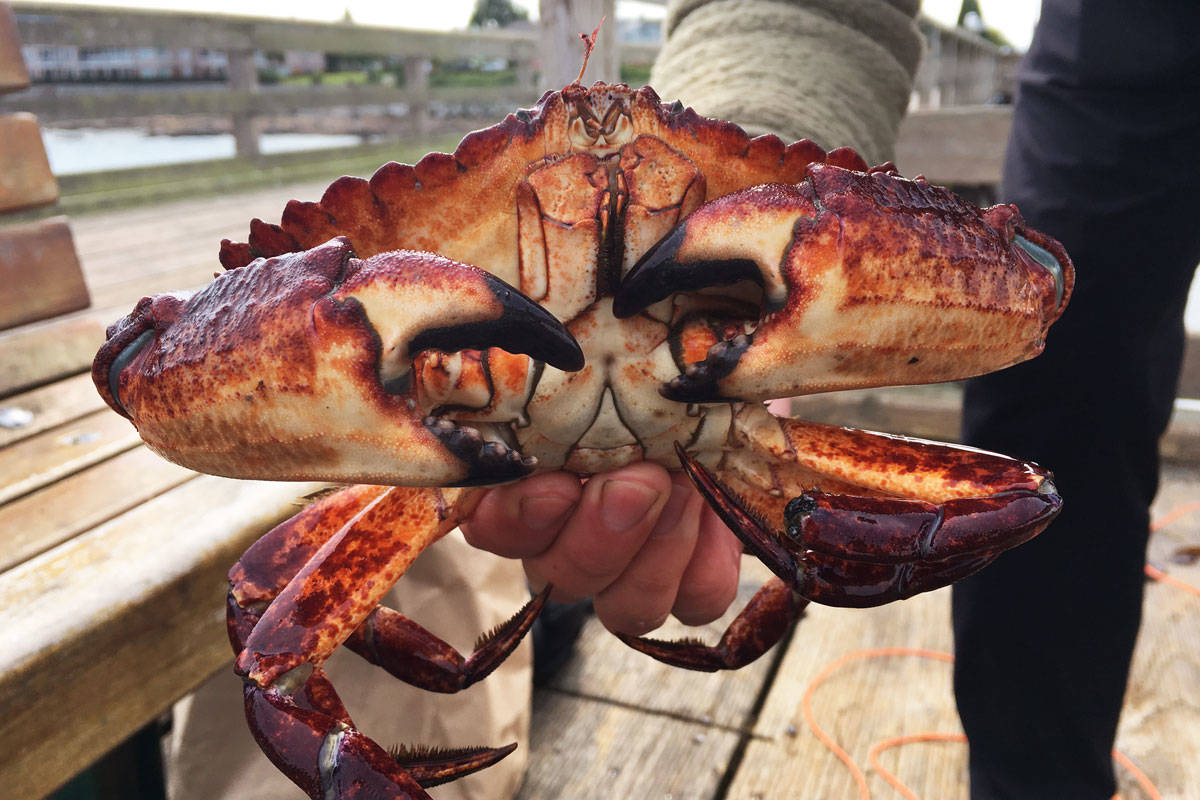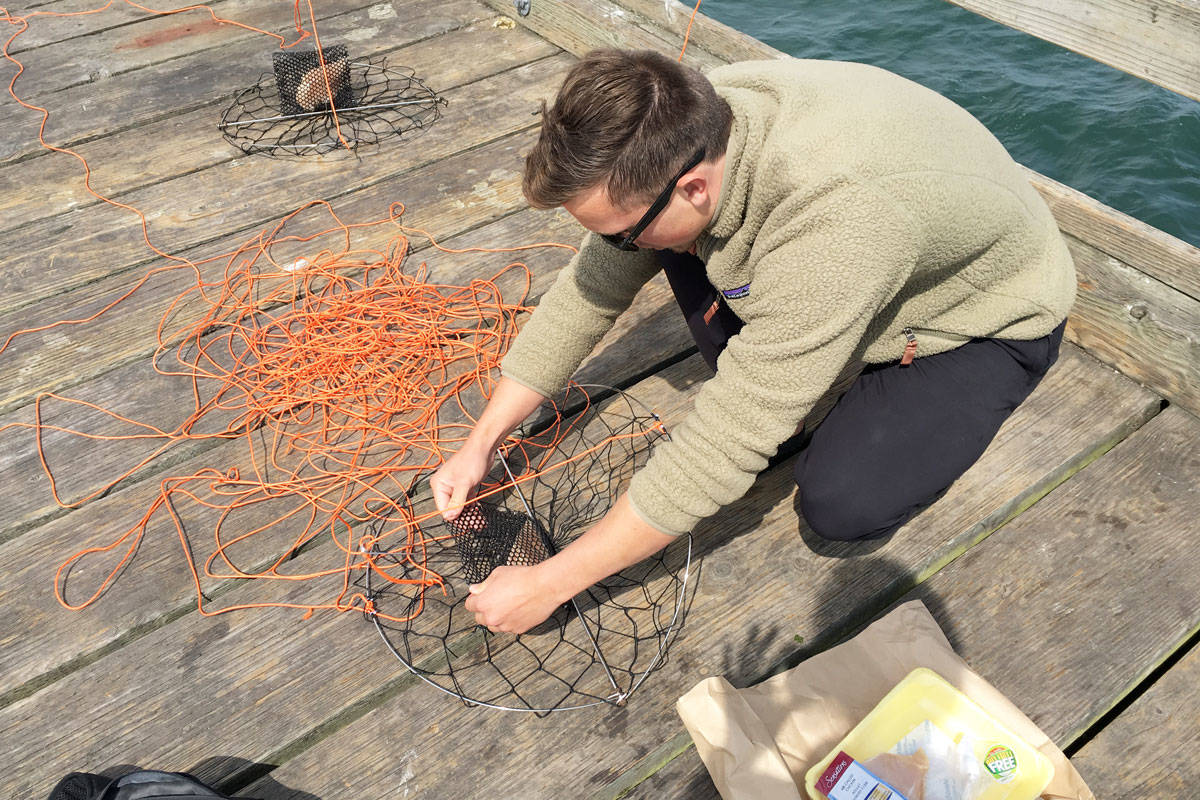On a cloudy day in early July, Stefan Randt makes his way to the end of the Sidney Fishing Pier and meticulously sets up his trap for an afternoon of crabbing. After securing the thin orange rope to the railing, he tosses the trap over the edge, squinting as the trap sinks beneath the murky waves and disappears from sight.
Crabbing is a fun pastime for some and a sustainable means of accessing food for others. For Randt, it’s both.
Randt, an engineering student at the University of Victoria, got into crabbing with his friends earlier this year. They choose different spots along the coast to set up their traps and have since had a number of crab dinners.
The success rate for fishing on the coast is low, he said, but with crabbing you’re almost guaranteed to catch something and you don’t need a boat. It’s easy, fun and inexpensive, he added.
The trap is circular and has a hinge in the middle. A mesh pocket for bait — usually raw chicken or fish — sits at the centre to attract the crabs. A rope attached to both sides of the circle draws the edges of the trap shut when the crabber pulls on it.
The traps typically cost between $15 and $20 and the required B.C. Tidal Waters Sport Fishing licence costs $22.05 per year for residents.
READ ALSO: ‘An extreme crisis for our sacred salmon’: B.C. rockslide threatens First Nations’ food security
Based on grocery store crab prices, Randt said the crab you catch on the first day will likely make up for the cost of the trap and licence.
“It’s kind of gratifying,” he said. “Especially being able to catch something and bring it home that day and cook it — you can’t get seafood that’s fresher than that.”
Randt learned how to trap, transport, butcher and cook crab by watching YouTube videos.
He leaves the trap for five to 10 minutes before pulling it up to see what he’s caught. The crabs can smell the bait and it doesn’t take long for them to get into the trap, he said. In fact, if you wait too long, they’ll climb out because they can’t get the bait out of the pouch.
Some people leave their bait outside to let it get extra smelly for the crabs, he explained.
“Or maybe to get everyone else off the dock,” Randt said with a laugh while dragging his trap up from the depths. After untangling a crab from the net, he plops it in a bucket of cool water. The crabs need to be kept alive until you’re ready to cook them because the meat goes bad quickly, he explained.
Randt lives in Saanich, but enjoys crabbing in Sooke and Sidney. He’s tried crabbing in the Cordova Bay area but was worried about the health of the crabs when he saw many of them had missing limbs and damaged shells.
According to Will Duguid, a PhD candidate at UVic who studied crabs for his master’s degree, missing limbs and worn-out shells are normal for crabs because the males are very territorial. He’s seen a crab missing more than half its limbs.
READ ALSO: Victoria named Canada’s top family friendly fishing town
Black spots on a crab’s shell are also not something to worry about. They’re just healed breaks, said Duguid. The spots stay black until the crab moults again. A grungy shell just means the crab is close to moulting. The meat is fine, he said.
At the moment, there are no diseases preventing crabs from being eaten in the area. However, the Department of Fisheries and Oceans Canada (DFO) doesn’t currently allow crabbing in Esquimalt Harbour due to a fuel spill in May 2016.
“People should always check our website before harvesting to ensure they are obtaining crabs from an open area,” said Michele Rainer, communications advisor for DFO.
Another notice from DFO points out that no more than 135 grams of crab hepatopancreas — the mushy, yellow substance under the shell — should be consumed in a week. This is due to dioxin contamination of the hepatopancreas.
Health Canada describes dioxins as a toxic chemical that is found in the environment and in some foods in small quantities.
According to the Canadian Food Inspection Agency, crab hepatopancreas can also contain toxins that cause paralytic shellfish poisoning.
“Just be aware of the regulations for what you can eat as well as what you can keep,” Duguid noted.
READ ALSO: Crab poaching under cover of darkness earns 10-year commercial fishing ban, vessel seizure
Only four male crabs of the correct size can be kept by a crabber — no matter the species. In terms of size, Dungeness crabs must have a shell width of 6.5 inches and red rock crab shells must be 4.5 inches wide. Crab callipers are often used to ensure the creatures are of the correct size.
Heavy harvesting in areas such as Victoria is, in theory, sustainable, said Duguid.
“You’re only allowed to take males that are big enough to have mated at least once,” he explained. The population shouldn’t be affected if the size regulations are strictly adhered to.
After a few hours of crabbing, Randt heads home with plans for a satisfying dinner. There are many ways to cook crab, but Randt recommends “one part crab, one part garlic butter.”
@devonscarlett
devon.bidal@saanichnews.com
Like us on Facebook and follow us on Twitter.

